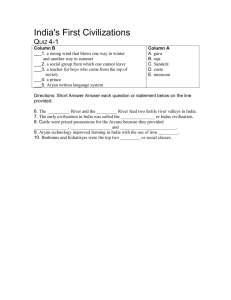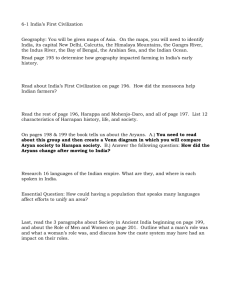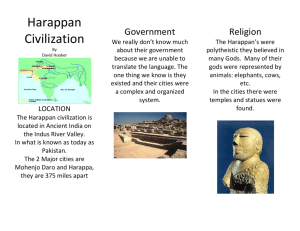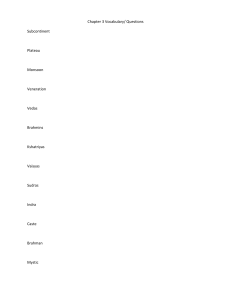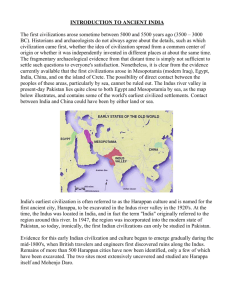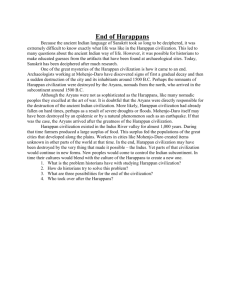Ancient India
advertisement
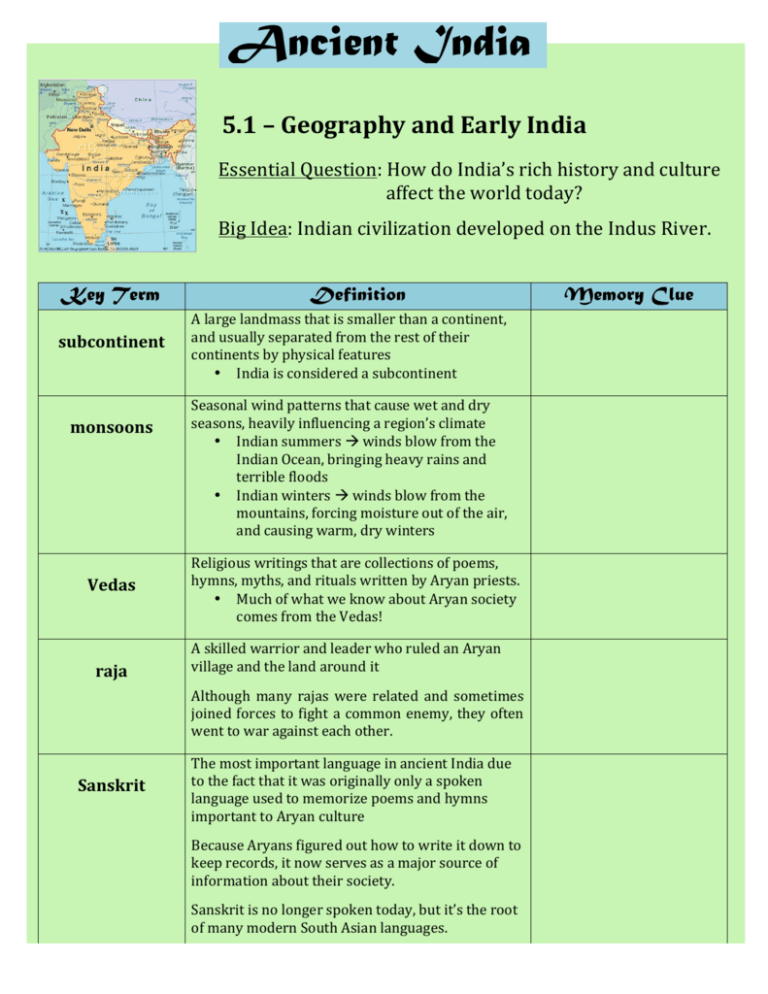
Ancient India 5.1 – Geography and Early India Essential Question: How do India’s rich history and culture affect the world today? Big Idea: Indian civilization developed on the Indus River. Key Term subcontinent monsoons Vedas raja Definition A large landmass that is smaller than a continent, and usually separated from the rest of their continents by physical features • India is considered a subcontinent Seasonal wind patterns that cause wet and dry seasons, heavily influencing a region’s climate • Indian summers ! winds blow from the Indian Ocean, bringing heavy rains and terrible floods • Indian winters ! winds blow from the mountains, forcing moisture out of the air, and causing warm, dry winters Religious writings that are collections of poems, hymns, myths, and rituals written by Aryan priests. • Much of what we know about Aryan society comes from the Vedas! A skilled warrior and leader who ruled an Aryan village and the land around it Although many rajas were related and sometimes joined forces to fight a common enemy, they often went to war against each other. Sanskrit The most important language in ancient India due to the fact that it was originally only a spoken language used to memorize poems and hymns important to Aryan culture Because Aryans figured out how to write it down to keep records, it now serves as a major source of information about their society. Sanskrit is no longer spoken today, but it’s the root of many modern South Asian languages. Memory Clue 5.1 -­‐ Geography and Early India Essential Question: How do India’s rich history and culture affect the world today? Big Idea: Indian civilization first developed on the Indus River. A. Geography of India India is known as a ____________________________________ of Asia. The __________________________ Mountains and the ________________________________ Mountains separate India from the rest of the continent. Most of India is covered by _____________________ plains and rugged _____________________, but to the west of the Himalayas is an enormous ________________________. The valley of the ______________________ River, which flows out of the Himalayas, was the location of India’s first ______________________________. Just like other rivers, the Indus _______________________, which caused a layer of fertile ___________________ to be left behind for ideal farmland. India’s _____________________ is hot and humid, which is influenced by seasonal wind patterns called ____________________________. In the summers, monsoons brought _______________ ________________ that caused terrible ______________________. In the winters, winds forced moisture out of the air, creating a ______________ and ____________ season. B. Harappan Civilization The first Indus River Valley civilization is called the _____________________ civilization. Just like other ancient societies, they grew as ______________________ and ______________________ improved. The food surpluses from the farms led to _________________, which led to the appearance of _____________________. We have information about Harappan civilization because of the ruins of two large cities, ____________________ and __________________ ________________. The two cities were similar, well planned, and each near a towering _________________. Most houses had bathrooms with __________________ _________________. Artisans created advanced goods, as well as a system of weights and measures. Harappans also developed India’s first _______________ ______________, but because we can’t interpret the language, we know little about their society. The society ended by the early _______________, but no one is sure why. C. Aryan Migration After the Harappan civilization crumbled, the ___________________ arrived in the Indus River Valley and became the dominant group in India. They first arrived in the ___________________ BC, crossing into India through _____________________ _________________ in the northwest. They eventually spread ____________ and ______________ into central India, then into the ______________________ River Valley. Much of what we know about Aryan society comes from religious writings known as the ________________. Although the Aryans were originally nomads, or wanderers, they eventually settled in __________________ and began to ________________. One big difference between the Harappans and the Aryans is that the Aryans did not build big _______________. They also had a different ___________________ system than the Harappans. Instead of having a king and central government, The Aryans lived in small ____________________________ based on family ties, each with its own leader. These leaders, often skilled warriors, were known as ____________________. Although many rajas were _________________, they did not always get along. At times, they would join forces to fight a common ________________, but other times, they would go to __________ against _____________ _________________. The first Aryan settlers did not ______________ or ________________, so in order to pass down information important to their culture, they needed to _________________________ it. This included poems and hymns such as the ________________. The language in which these poems and hymns were composed was _________________________. At first, it was only a spoken language, but eventually, they figured out how to _________________ it down to keep records. These ______________________ records are a major source of information about __________________ society. Main Idea #1: The geography of India includes high mountains, great rivers, and heavy seasonal rain. Q: What is the shape of the Indian subcontinent? A: Q: How is the geography of the northeastern part of the subcontinent different from the northwestern? A: Q: Why may Indian farmers consider the monsoons both a blessing and a curse? A: Main Idea #2: Harappan civilization developed along the Indus River. Q: What were the two main cities of the Harappan civilization? A: Q: When did the Harappan civilization thrive? A: Q: What are some explanations for why Harappa and Mohenjo Daro were very similar? A: Q: How do we know about Harappan civilization? A: Q: What are some characteristics of the cities of Harappa and Mohenjo Daro? A: Main Idea #3: The Aryan migration into India changed the region’s civilization. Q: From where did the Aryans come? A: Q: How was the Aryan civilization different from the Harappan? A: Q: Why are the Vedas so important to historians? A: Q: Why did the Aryans memorize their poems and hymns? A: Reading Checks Q #1: How do you think monsoons affected settlement in India? A: Q #2: Why don’t we know much about Harappan civilization? A: Q #3: What source provides much of the information we have about the Aryans? A: Map of India This country is called… China These mountains are called… This river is called… This river is called… This country is called… This sea is called… This bay is called… Word Bank Indian Ocean Bay of Bengal Arabian Sea Ganges River Indus River China India Himalaya Mountains This ocean is called… 1. What major river was the basis of the first Indian civilizations? ___________________________________ 2. Geographers call India a subcontinent. Give explanations as to why. _______________________________________________________________________________________________________________________ ____________________________________________________________________________________________________________________ 3. The Indus River flooded frequently leaving behind a grained soil called silt. Why is this important? _______________________________________________________________________________________________________________________ 4. Name the two other civilizations that have grown up around the river systems listed below. Nile River-­‐ _______________________ Tigris and Euphrates Rivers-­‐ ________________________

